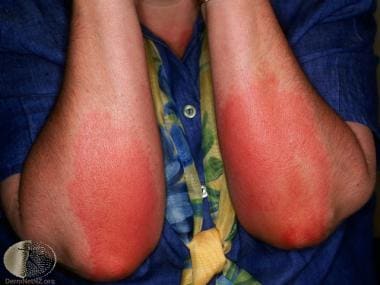Background
Pressure urticaria is an uncommon form of physical urticaria, a subset of chronic urticaria, which presents with erythematous swelling at sites of pressure. Chronic urticaria is termed when patients have ongoing urticaria for more than 6 weeks. An inciting event or etiology is usually not identified for patients with chronic urticaria—hence the term chronic idiopathic urticaria (CIU) is often used. A proportion of patients diagnosed with chronic urticaria have physical urticaria, also referred to as chronic inducible urticaria (CIndU), [1] which is urticaria incited by a physical stimulus, such as mechanical (friction, vibration, pressure) urticaria, thermal (heat or cold) urticaria, solar urticaria, and symptomatic dermatographism. [2, 3]
Pressure urticaria may occur immediately (within minutes) or, more commonly, 4-6 hours after a pressure stimulus. [3, 4] For this reason, the term delayed pressure urticaria (DPU) is typically used. It appears as an erythematous, cutaneous, and often subcutaneous edema. The reaction may last up to 72 hours and can be associated with pruritus, burning, and pain. [5] Pressure sites, including the hands, feet, trunk, buttocks, and legs, are most commonly affected. Lesions can be induced by a variety of stimuli, including standing, walking, wearing of tight clothes, and sitting or leaning on a hard surface. [6] See the image below.
Pathophysiology
The pathogenesis of delayed pressure urticaria (DPU) is relatively unknown. Although the trigger stimulus of pressure is identified, no allergen has been established. Urticaria (hives) is a type I hypersensitivity reaction, where autoantibodies against IgE molecules are involved. When an antibody or autoantibody binds to the IgE molecule, a bridge is formed between two or more IgE molecules. This induces mast cell degranulation, releasing multiple proinflammatory mediators, including histamine, leukotriene, and prostaglandin. In chronic idiopathic urticaria (CIU), the mast cells are inappropriately activated. [3, 7]
Histamine levels are increased in the lesional skin, while intracellular histamine levels are decreased in peripheral white blood cells. [8] There is also an increased stimulation of histamine release. Despite these findings, histamine is unlikely to be the sole mediator in pressure urticaria. This is further demonstrated in the inconsistent effectiveness of antihistamine treatment in pressure urticaria.
Other mediators are believed to be involved, and mast cells may be triggered by IgE-independent pathways. Patients with chronic inducible urticaria (CIndU) have increased serum levels of IgE. [3] This includes eosinophils (as suggested by the presence of eosinophilia), eosinophil cationic protein (ECP), and eosinophil cationic factor (ECF) found in biopsy specimens from select patients with DPU, particularly those with bullous DPU. [9, 10] In addition, elevated concentrations of interleukin (IL)–1a, IL-5, and IL-6; tumor necrosis factor (TNF)–alpha; and leukotrienes have also been found in lesional skin of pressure urticaria patients. [11, 12, 13] Vascular endothelial growth factor has also been found to be elevated in patients with DPU. [14] Abnormalities in platelets and fibrin or fibrinolysis have also been investigated. [15, 16] Systemic inflammation has also been suggested, with elevations seen in C-reactive protein (CRP) and sCD40L, a platelet activator. [17, 18]
Etiology
Pressure stimuli may include the following [3, 6] :
-
Standing, walking, leaning, or sitting
-
Using tools
-
Carrying a handbag or backpack
-
Wearing tight-fitting clothes (eg, bra straps or watches)
Occasionally, delayed pressure urticaria (DPU) is aggravated by heat, aspirin, or menstruation. Exacerbation of the condition during medical procedures is a reasonable possibility; urticaria flares following endoscopy have been described. [19]
Epidemiology
Delayed pressure urticaria (DPU) is generally considered a rare entity; however, this may be because it is not consistently recognized. [1] Approximately 37% of patients with chronic spontaneous urticaria also have pressure urticaria. [1, 20]
The mean age of onset of DPU is in the 30s (range, 5-63 y). [21] DPU is slightly more common in men than in women.
Prognosis
Delayed pressure urticaria (DPU) is a chronic disease that can last for years (mean, 9 y; range, 1-40 y). [21] The morbidity of DPU varies, depending on the severity and the response to treatment. In some patients, this condition can be disabling, especially in patients who perform manual labor.
Quality-of-life (QOL) tools have demonstrated that patients with urticaria can show impairments in QOL scores similar to those seen in patients with chronic dermatoses such as psoriasis and atopic eczema. QOL scores were lowest for patients with chronic idiopathic urticaria (CIU) compared with psoriasis and atopic dermatitis for “self-perception,” “social functioning,” and “treatment-induced restrictions.” [22]
-
Delayed pressure urticaria. Courtesy of DermNet New Zealand (http://www.dermnetnz.org/assets/Uploads/reactions/pressure2.jpg).










